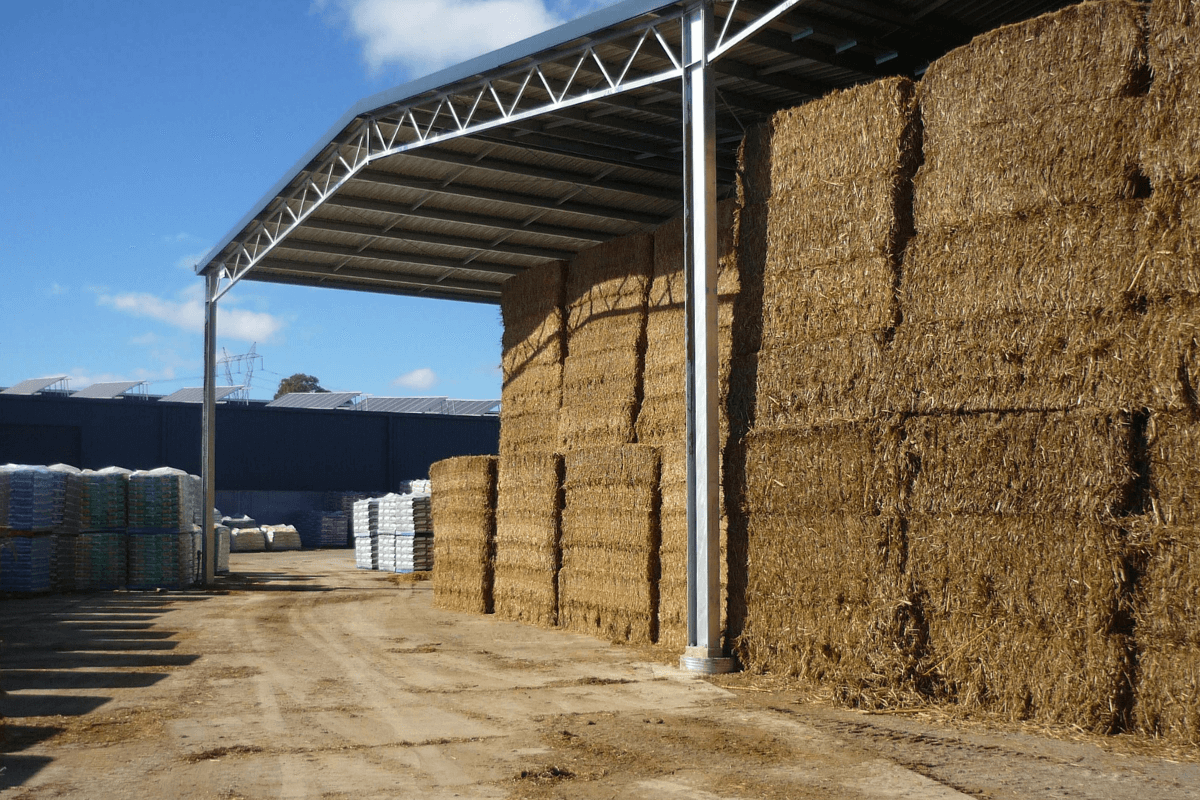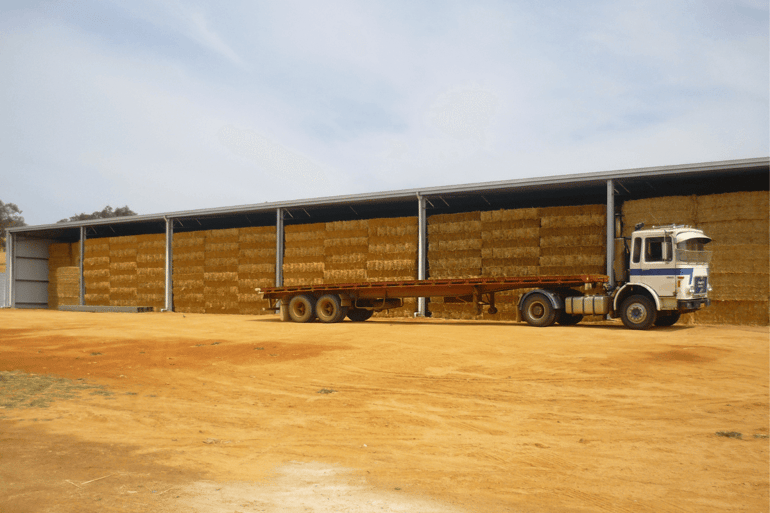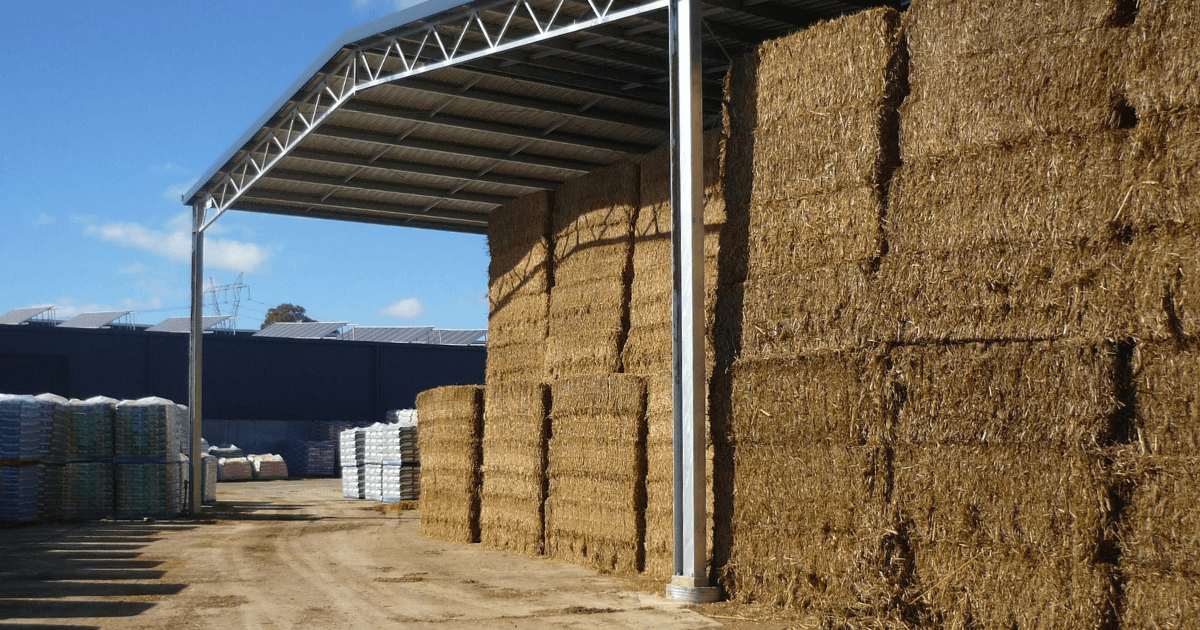How much hay can be stored in a hay shed?

For hardworking farmers, having the right amount of hay storage is crucial. A well-designed hay shed will not only keep your hay dry and full of nutrients, but it will also be a valuable long-term investment for your farm.
The question is – how much hay can your shed store? Getting this wrong could lead to wasted hay and money.
In this article, we discuss the key factors that determine how much hay you can store in your shed. Additionally, we also share our most popular hay shed sizes and the bale capacity of each.
Benefits of hay storage
Effective hay storage preserves nutrition, reduces waste, allows for higher sale prices, reduces fire risk, and keeps your storage area clean and organised. Investing in a reliable storage shed for your farm is well worth the initial investment. You will see benefits which include:
- Adaptable and multi-purpose
- Convenient on-site storage
- Preserves hay quality and nutrition
- Protects your hay from the elements.
Factors of hay shed size
When storing hay, there are several influencing factors to consider, including your hay usage, crop overflow, stack height, bay spacing, fire safety, and additional storage.
Hay usage
To calculate your annual hay usage, you can sign up with Meat and Livestock Australia and use their Feed Demand Calculator. By determining how much hay your livestock consume and any gaps in their feed cycle, you can decide how much storage capacity your new shed will need.
Bumper crops
If you grow hay on your farm, you will also need the capacity to store bumper crops. The amount of hay you grow each year will vary based on weather, fertiliser, and the length of active growth time. To be prepared for any overflow, you must choose a shed with more storage than you ordinarily use.
Stack height
The maximum height for stacking hay depends on the type of hay, the method of stacking, and the size of the bales. Additionally, stacking height is regulated differently in each state, meaning you will need to consult with your local authorities or farming organisations for the most up-to-date information.
In addition to legal requirements, it is critical to use the correct stacking techniques. A good rule of thumb is to ensure your stack is no higher than 1.5 times the shortest base dimension. For example, if a stack is 4.8m wide and 12m long, then a safe height is equal to or less than 7.2m.
Bay spacing
Typically, 8m bay sizes are the preferred size for hay sheds. This is because they allow enough room for three large square bales next to each other, while still allowing adequate airflow. Additionally, you need to consider how easy it is to load and unload the bales. Depending on your bale size and machinery, the appropriate spacing will vary.
Remember to allow for the following:
- Room to walk
- Door clearances
- Vehicle and machinery access
- Workshop space
- Vehicle storage

This custom hay shed features wide 8m bays which provides optimum room for hay storage and much more!
Fire safety
The risk of fire is a major concern when storing hay. In addition to complying with local fire safety codes and regulations, you also need to keep ventilation and moisture content in mind.
Proper ventilation helps prevent the build-up of heat and spontaneous combustion. By investing in a large enough shed with airflow around the bales, you can reduce this risk. Secondly, a higher moisture content also increases the risk of fire so it's wise to store hay when it has been properly dried.
Additional storage
As well as the hay itself, it is worth incorporating extra space for any farm equipment or bumper crops. If in doubt, choose a shed that has more capacity than you currently require so that you’re prepared for any future growth.
For insurance purposes, it’s important to note that you may be wiser to build multiple, smaller sheds, rather than one large shed. Many insurance providers prefer smaller sheds as it reduces the risk, should a fire occur. It’s important to consult with your insurer before you invest so that you’re aware of any potential limitations.
Average hay shed capacity
Based on our most popular hay shed sizes, the following capacity estimates provide a helpful guide:
32m by 18m hay shed
This is the smallest of our standard hay sheds, suitable for small farms or farmers needing more than one shed. The maximum storage capacity is 1,000 bales.
48m by 24m hay shed
This is our most common hay shed size, suited to small to medium farms. The maximum storage capacity is 2,500 bales.
If you have a larger farm and more hay to store, investing in more than one of these sheds will protect your crop from fire damage, and provide added convenience.
96m by 24m hay shed
For large farms storing 5,000 bales at the height of the season, a 96m by 24m shed will be a suitable choice. For sheds of this size, you will need to install a water tank for fire protection.
160m by 45m hay shed
Ideal for hay exports, this sized shed has a maximum capacity of 20,000 bales. However, it may be wiser to invest in multiple smaller sheds instead. This way, your farm is covered if a hay fire occurs – at least a portion of your crop will be kept safe.
If you need to preserve the quality of your hay, contact the team at ABC Sheds. We understand the importance of effective hay storage which is why we offer a wide range of sheds to suit the diverse needs of farmers all over Australia.
Whether you require a standard design that is readily available or a customised solution tailored to your specific requirements, we have you covered. We’ll provide you with a durable and functional hay shed to keep your hay in pristine condition all year round. Find out more about our hay sheds today.
-1.png?width=3641&height=660&name=abcshedstransparent2%20(1)-1.png)




%20(1).webp?width=352&name=abc_sheds_blogs_building_a_hay_shed%20(1)%20(1).webp)